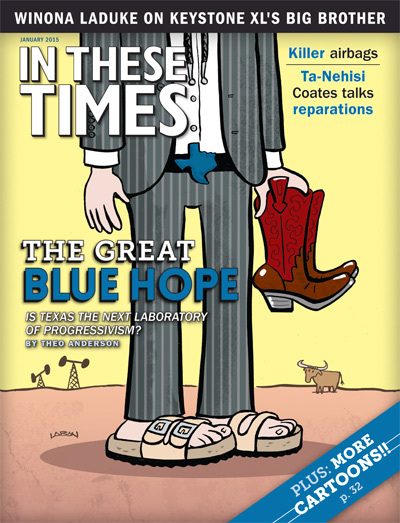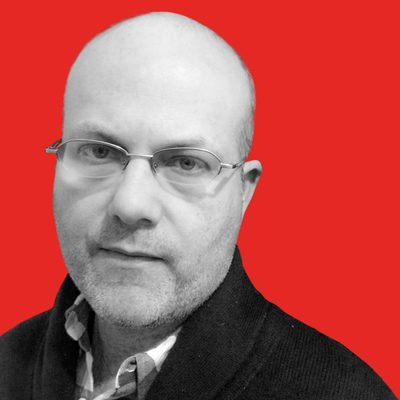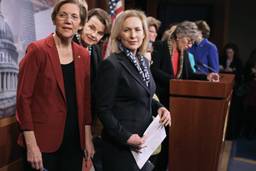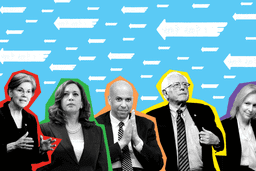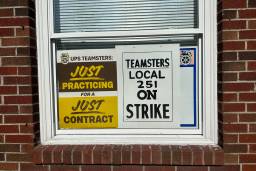Texas: The Blue Frontier
Texas won’t turn blue from the top down, but it may already be doing so from the ground up.
Theo Anderson
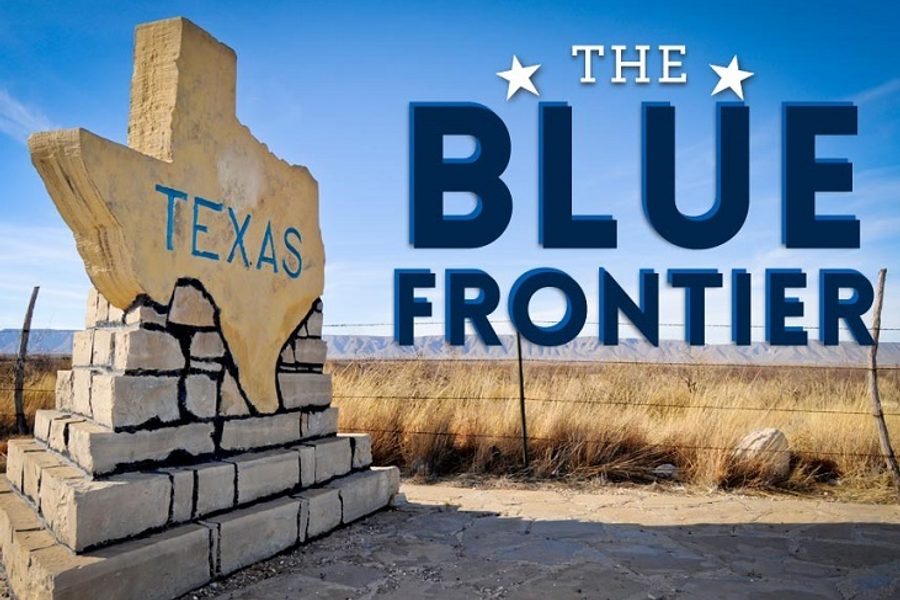
Have you heard the one about turning Texas blue?
It may seem like a joke after the midterm elections. Wendy Davis, the Democrats’ once-promising candidate for governor, got only 39 percent, and Republicans increased their majority in the state legislature.
Still, it’s easy to see why 33,000 volunteers gave their time last fall to Battleground Texas, a get-out-the-vote effort to deliver the Lone Star State to the Democrats. Though Texas ranks second to California in Electoral College votes, 55 to 38, no state looms as large on the U.S. political horizon. For conservatives, Texas embodies everything that makes America great. For progressives, it delivers one outsized and calamitous politician after another.
The idea that Democrats might “flip” the crown jewel of American conservatism has been great entertainment for pundits, whose speculation smacks of Christian end-times prophesying. Will it happen by 2024? Sooner? Ever? The New Republic published a classic of the genre in 2013, offering “eight charts explain[ing] why ‘blue Texas’ won’t happen.” Jon Stewart’s Daily Show piled on last fall, comparing Democrats who think they can win Texas to a guy who believes he can “flip” a lesbian: “I just need time!”
Talk of flipping Texas generally centers on its role in presidential elections, because adding it to the list of safely blue states would guarantee Democrats a lock on the executive branch. The discussion hinges on the state’s demographics. In 2013, the population was about 44 percent white, 38 percent Hispanic, and 12 percent African-American. By 2020, the white and Hispanic share of the population will be roughly equal, at 41 percent. Democrats typically get at least 90 percent of the African-American vote and about two-thirds of the Hispanic vote in residential elections, which means that Texas should turn blue in 2020 — all things being equal.
But all things are not equal. Voting eligibility rates are lower among Hispanics than the general population. There are an estimated 11 million undocumented immigrants in the United States, 59 percent of whom are from Mexico — and Obama’s temporary amnesty for 5 million does not include voting rights. Voting rates among eligible voters are also lower among Hispanics than the general population. In the 2014 midterm elections, an estimated 31 percent of eligible Hispanics voted, versus 36 percent of the eligible population overall.
Predicting when Texas will flip is so uncertain because we can’t know how much, how soon — or even whether — voting behavior will change. We also can’t know how successful the GOP’s efforts to suppress the vote, by limiting access to polling places and requiring government-issued ID, will be. An estimated 600,000 registered voters in Texas lacked the required ID in 2014, disproportionately affecting Black and Hispanic voters.
What we do know is that Texas is a state in flux, with a simmering sense of crisis and opportunity. Several 21st century challenges are felt acutely there: How to address the needs of an immigrant population that’s been relegated, in many cases, to second-class citizenship. How to create a new and sustainable future for ourselves, environmentally, as our water and energy sources become increasingly unsustainable. And how to resist the neoliberal education “reform” movement that has swept the nation — much of which was incubated in Texas and exported as President George W. Bush’s No Child Left Behind program.
Because it is such a lodestar in our political life, it’s easy to be reductive about Texas. Those who want to squeeze it into the familiar red/blue paradigm may be surprised to learn that Texas is already substantially blue, and that in the face of its challenges, progressives are stepping up. Perhaps most surprisingly, in the state that gave us creationism in textbooks and Big Oil, there is significant progressive energy in the realms of education and the environment.
It may be jarring to think of Texas as “a laboratory for experimentation and action” toward progressive goals, as the Houston Chronicle recently wrote of an environmentalist initiative supported by Houston’s mayor. But the progressive leaders and infrastructure that are emerging in the state right now are transforming it into just that. The ramifications will be far-reaching regardless of when Texas formally flips. Nothing in our political universe can resist the gravitational pull of the Lone Star State.
New York State of Mind
There is a precedent.
In the first third of the 20th century, progressivism emerged as a coherent movement in New York in response to a rapid rise in the state’s population, which doubled between 1890 and 1930 — from 6 million to more than 12 million people. In the same span, New York City’s population more than quadrupled, from 1.5 million to nearly 7 million people. Immigrants accounted for at least a third of the city’s population throughout these decades, and issues such as assimilating immigrants, caring for the poor and elderly, and implementing basic protections for working people came to the fore.
In 1911, labor activists were galvanized by a fire on the top floors of the Triangle Shirtwaist Company in New York City. The workplace was overcrowded and lacked emergency exits, and 146 garment workers — the majority of them women, and recent Italian and European Jewish immigrants — died, many of them jumping to their deaths. The spectacle was so horrific — and so stark in making visible the conditions of factory workers — that it provoked a wave of workplace reforms and progressive activism for two decades, culminating in the New Deal.
One important force in this broad-based movement was Frances Perkins. In the 1910s, she advocated for various reforms to improve the lives the poor, especially immigrants. In the 1920s, she served in the administrations of two New York governors, Al Smith and Franklin Roosevelt, and was instrumental in the passage of worker protection legislation: a minimum-wage law, a 40-hour work week, unemployment compensation and a ban on child labor.
The Great Depression amplified the state-level solutions championed by Perkins — and a broad range of other activists — into a national program. When Roosevelt was elected president in 1932, he invited Perkins to be his secretary of labor. She agreed on the condition that he support the kind of legislation that she had helped enact in New York. It is fraying and inadequate, certainly, but America’s social safety net can be traced directly to the activism and experimentation in New York in the 1910s and 1920s.
Before voting for FDR in 1932, New York had gone to the GOP candidate in eight of the previous 10 presidential elections. In other words, the movement-building that preceded the New Deal took place in the laboratory of a large state that was a Republican stronghold in presidential politics. Sound familiar?
It took the crisis of the Great Depression to turn the reforms pioneered in New York into a national program. Transferring the activism in Texas to the national stage might also take a crisis, but more likely it will be the same method that has made Texas a powerhouse of the conservative movement: years of cultivating leaders, building infrastructure and passing legislation.
“Part of the reason we feel so frustrated and maybe discouraged is that [change] isn’t happening fast,” says Josiah Heyman, president of the board of Border Network for Human Rights (BNHR) and a professor at the University of Texas-El Paso. “But…there are all kinds of movements and efforts in Texas.”
And just as the Triangle Shirtwaist fire focused a national spotlight on the plight of immigrants and the working poor a century ago and helped to inspire a wave of reform, the border is home to appalling abuses that are galvanizing progressives to fight back.
The new Ellis Island
One area of common ground among conservatives and progressives is the notion that the U.S. border with Mexico foreshadows our national fate. More than 1,200 of the nearly 2,000 miles of that border lie in Texas.
For the GOP base, the border represents chaos and violence. In 2010, for example, Texas Gov. Rick Perry lamented “bombs exploding in El Paso.” Not only were there no bombs but El Paso regularly has the lowest crime rate of any large city in the nation. Perry was likely stoking fears of chaos spreading from the city’s neighbor across the border, Ciudad Juarez, which had the world’s highest reported homicide rate that year.
The progressive spin on the border-as-future idea often spotlights its militarization as a symbol of the expanding police state in the United States. But the progressive take also envisions the border as a proving ground for new policies.
Rep. Beto O’Rourke, an El Paso Democrat, has emerged as a leading voice in Congress on immigration reform. O’Rourke and a Republican representative from New Mexico, Steve Pearce, have co-authored legislation that would increase congressional oversight of border patrol agents and create new infrastructure to investigate human-rights abuses. The bill has little chance, however, in the new Congress.
El Paso is the second-largest border city (San Diego is the largest), with about 830,000 people in its metropolitan area, 81 percent of whom are Hispanic. It’s also home to a network of activists working to achieve basic justice for low-wage workers, especially immigrants.
In 2011, BNHR and ally organizations published a report on “El Paso’s newest crime wave” — wage theft. It found that about one-fifth of the city’s low-wage workers received less than minimum wage. The same year, a state legislator from El Paso set up a “wage theft task force,” consisting of law-enforcement agencies and two social justice groups. In 2013, the first employer in El Paso was indicted and arrested for wage theft.
More recently, activists and groups aligned with the task force have been part of a push to pressure El Paso City to adopt a wage theft ordinance modeled on the one Houston passed in 2013, which prohibits the city from contracting with businesses that have a record of wage theft. In October, the El Paso City Council voted unanimously to begin working on the legislation. In a report, “The New Ellis Island,” BNHR predicts that such initiatives will catch on: “We believe that policies tested at the border will one day make it into the interior.”
Taking on wage theft is a largely defensive battle — a struggle to attain basic fairness. But Texas is also home to efforts to engage Latinos in a deeper way in the political process. Michael Seifert of the Rio Grande Equal Voice Network, for example, works to organize “the poorest of the poor,” many of whom live in shanty towns along the southern-most portion of the border. He aims to help border residents see political engagement not just as the act of voting on Election Day, but as a way to take part in, and shape, the institutions that directly affect their lives. That means going to city council and school board meetings, holding discussions about the current session of the state legislature, and generally helping people learn the machinery of politics at the local and state levels.
“Folks find that to be an extraordinarily powerful experience,” Seifert says. “It leads directly into electoral politics, because it’s that simple experience of saying, ‘Oh my God. This is possible.’ And that carries an extraordinary punch in people’s lives.”
Seifert estimates that voting rates are only 25 percent in the communities he works with. If increasing the Hispanic vote is the key to turning Texas blue, building more political infrastructure is, perhaps, a better strategy than periodic get-out-the-vote efforts like Battleground Texas.
Green giant
Houston, San Antonio and Austin are home to a metro area of more than 10 million people, forming an urban triangle in southeastern Texas that is the fastest growing region in the nation. It is also emerging as a national testing ground for environmentalist initiatives, partly out of necessity given that the state is vulnerable to droughts.
Since it was created in 1992, the San Antonio Water System has been the cutting edge of innovation in water conservation and energy management. It recycles the city’s wastewater for non-potable uses by city departments and local industry, and it captures and recycles the byproducts of that process. Per capita water usage in the city declined from about 200 gallons per day in the 1980s to about 140 gallons per day by 2011.
In the field of renewable energy, there is a deeply ironic, competitive drive behind much of what’s going on in Texas. The state’s identity has long been tied to its role as a leader in oil production. Now, that identity is shifting toward its role as a leader and innovator in renewables.
In 2012, for example, director of Houston’s Office of Sustainability wrote that the city, “is at an historic juncture. There is an emerging recognition that the city has the building blocks to be one of the most livable, equitable, and sustainable places in the nation and lead the next revolution: the Green Revolution.”
In 2014, the EPA singled out Houston for a “Green Power Purchasing Award,” noting that the city had reduced its greenhouse gas emissions by 32 percent since 2007, and that it was committed to another 10 percent reduction by 2016. About half the power in municipal buildings comes from renewables. Austin does even better. In 2011, it became the first city to use 100 percent renewables in its municipal buildings, and the city is home to some of the most aggressive and ambitious environmental initiatives in the nation.
In August, the City Council passed Resolution 157, which instructs the city-owned power company, Austin Energy, to rely on at least 65 percent renewable energy sources by 2025 and to produce zero carbon emissions in the power-generation process by 2030, which would mean closing a coal plant and a gas-fired plant and dramatically increasing its reliance on solar. A headline: “Austin Just Became a National Leader in Solar Energy.”
Austin Energy has pushed back, arguing that closing the coal and gas-fired plants will drive up costs for consumers. Activist groups, meanwhile, are pressing the City Council to stand its ground over the details of the plan’s implementation, which were in the midst of being finalized as In These Times went to press.
“The Decker gas plant is the worst single source of pollution in Travis County,” says Vanessa Ramos of Austin Climate Action Network, part of an environmentalist coalition. She notes that pollution from such plants disproportionately affects low-income communities.
Activists in Houston recently critiqued a proposed new recycling program on similar grounds. They argue that the processing facilities will likely be located in communities of color, and will generate potentially harmful emissions. Critics also warn that the plant will rely on technology that is unproven. Houston is moving ahead with the plan despite the opposition.
Such battles raise a crucial question: Houston and the region that it anchors are emerging as models of environmentalism, but will they become models of genuine sustainability and environmental justice?
Teach the children well
Even beyond the No Child Left Behind program, Texas has shaped public education in the United States in profound ways. Since publishers can ill afford to offend the conservative Texas State Board of Education, the state has tilted textbooks in a distinctly conservative direction.
But recently, progressives in Texas have begun to push back. In 2011 the young superintendent of a small school district in northern Texas wrote an open letter modeled on the 1836 missive sent by the leader of the people holed up in the Alamo. “I am besieged by a hundred or more of the Legislators under Rick Perry,” it began. “The ruling party has demanded another round of pay cuts and furloughs, while the school house be put to the sword and our children’s lunch money be taken in order to keep taxes low for big business.”
Its author, John Kuhn, has subsequently become a quasi-celebrity among critics of neoliberal education “reform.” He has published two books—Fear and Learning in America and Test and Punish—and is a frequent speaker at conferences and rallies. Last March, he delivered the keynote speech at the national Network for Public Education Conference, held in Austin. He remains the superintendent of the Perrin-Whitt Consolidated Independent School District, the same school system he attended as a child, located about 100 miles northwest of Dallas.
Kuhn spent two years doing Christian missionary work in Peru, and he delivers speeches with the urgency of a prophet. “Public education is our trust fund, our nest egg,” he said at the Austin conference. “It belongs to our kids, and the kids of our kids, and nobody else can have it. They can’t take it away from us without a fight. We love our kids more than they love their portfolios.”
Kuhn may sometimes appear to be a lone voice crying in the wilderness of northern Texas, but he is just the most visible face of ideas and energies that have been percolating within the state for several years.
In 2006, a group of 35 superintendents of Texas schools came together for the first of a series of workshops focused on creating an alternative vision to the reigning paradigm of high-stakes testing.
In 2008, the superintendents published a working document titled “Creating a New Vision for Texas Public Education.” It set forth the goal of creating schools “that foster a sense of belonging and community and that inspire collaboration” and “that delight students, develop their confidence and competence, and cause every child to value tasks that result in learning.”
When he began his job as a school superintendent in 2010, Kuhn was organizing his office one day and found a copy of the document in a desk drawer.
“I was just captivated by this positive, progressive vision for the future of Texas,” he said. “That how we treat kids, how we treat communities, how we treat the professionals who work in our schools, can be an uplifting, community-building, individual-building experience. Instead of this constant tearing down.”
This work has been carried forward by the Texas Association of School Administrators, supported by parents and community members, in an effort called “MISSION: School Transformation.” Most of that work goes on at the local school level, under the radar, but the movement’s opposition to standardized testing has had concrete legislative results. In 2013, under pressure from educators and activist groups like Texans Advocating for Meaningful Student Assessment, the Texas state legislature reduced the number of end-of-course tests that high school students must pass in order to graduate — from 15 to 5.
Kuhn has called the bill’s passage “a watershed moment” — a small yet significant retreat from decades of increasing emphasis on high-stakes testing in Texas public schools. As the Dallas Morning News put it, “What happened in Texas is being watched across the nation.”
Ironically, the best hope for reversing the influence of Texas in our public schools — and fashioning an alternative, progressive agenda — might be Texas itself.
Politics 101
Why does the turning tide in Texas matter so much?
Its size, for starters. More people, cities and institutions allow for denser networks and opportunities for creative exchange — and greater potential for nationally influential leaders like John Kuhn to emerge from those networks and exchanges. But there is more to it than that.
The New Right was galvanized by a definition of morality grounded in conservative religious belief, and for nearly four decades the GOP has been the party of “faith and values” — linked tightly to individualism and free markets. Texas matters because, more than any other state, it is a laboratory in which the progressive vision of the common good stands in stark contrast to — and in deep tension with — conservative ideas about morality and up-by-the bootstraps individualism.
The reforms that presaged the New Deal were about more than creating jobs. They were about our obligations to one another. As Franklin Roosevelt said in 1933, in his First Inaugural Address: “These dark days, my friends, will be worth all they cost us if they teach us that our true destiny is not to be ministered to but to minister to ourselves and to our fellow men.”
What’s going on in Texas is about more than 38 Electoral College votes. It’s about asserting — and reaffirming— fundamentals and first principles.
“I get a little fired up when I see something that is pretty evidently not moral in the way people are treating other people,” says Kuhn. “And I get really angry when I look at the inequity that we as a society, as a state, have blessed.
“We’ve put it on the law books that we’re going to inequitably fund our schools: We’re going to give healthy kids in this neighborhood X amount of dollars, and we’re going to give these other kids — farm kids in communities like mine, kids on the border, kids in the inner city — half as much money but expect them to score the same on tests. And when they don’t, we’re going to act like something’s wrong with them, or their teachers, or their town or community. If it weren’t for my faith, I’d probably keep my mouth shut and cruise to retirement. But I can’t be like that.”
The recent midterm election results showed that Texas is still solidly red, and that its much-prized Electoral College votes are still on the horizon, as distant as they ever were. But perhaps the journey is more important than the destination. Perhaps Texas will transform our politics and reinvigorate the progressive movement — and the Democratic Party — not just through the quantity of what it can offer during the coming decades, but through the moral force of its model.
